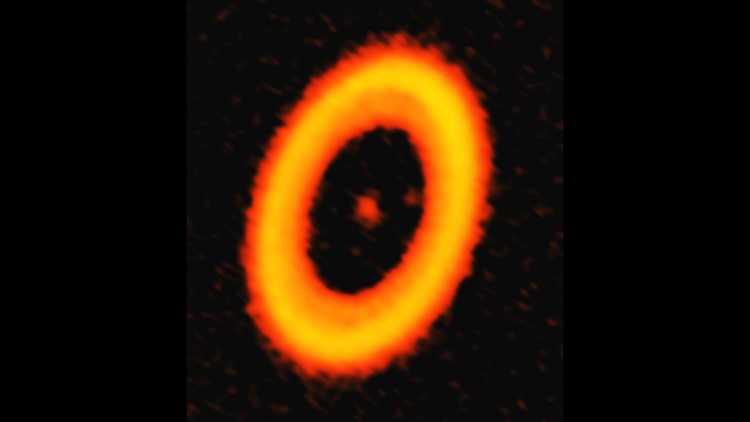The story of exoplanet PDS 70 c, the focus of the first confirmed image of a newborn planet still forming in our galaxy, becomes curioser and curioser.
Astronomers have now made the first observations of a moon-forming disk around the planet in a star system 370 light-years away.
Last month, astronomers photographed PDS 70 c and another exoplanet, PDS 70 b, discovering that two juvenile exoplanets are still growing as they orbit the young star PDS 70. This is only the second system with more than one planet to be captured in an image.
The star is 6 million years old. PDS 70 is smaller and less massive than our sun, and it’s still gathering material. Around the star, there’s a large disk made of gas and dust. And carving out a wide gap within that disk are the two planets, PDS 70 b and PDS 70 c. The gap is between 1.9 billion and 3.8 billion miles.
Both planets are massive Jupiter-like gas giants. And new observations by the Atacama Large Millimeter/submillimeter Array revealed evidence of a dust-filled disk around PDS 70 c that could form multiple moons.
“Planets form from disks of gas and dust around newly forming stars, and if a planet is large enough, it can form its own disk as it gathers material in its orbit around the star,” said Andrea Isella, an astronomer at Rice University in Houston and lead author of a paper describing the disk that was published in the Astrophysical Journal, Letters. “Jupiter and its moons are a little planetary system within our solar system, for example, and it’s believed Jupiter’s moons formed from a circumplanetary disk when Jupiter was very young.”
The circumplanetary disk is essentially the leftovers from the two planets that are forming in the star system.
Isella and his fellow researchers have searched for young star systems in order to find planets that are still forming the remaining disks. Planet formation models have suggested that these disks disappear in 10 million years. That means they haven’t existed in our solar system for more than 4 billion years, the researchers said.
“There are a handful of candidate planets that have been detected in disks, but this is a very new field, and they are all still debated,” Isella said. PDS 70 b and 70 c “are among the most robust because there have been independent observations with different instruments and techniques.”
Directly observing planet formation and the disks that can form moons around these planets will allow astronomers to test their theories about how planets come to be.
“There’s much that we don’t understand about how planets form, and we now finally have the instruments to make direct observations and begin answering questions about how our solar system formed and how other planets might form,” Isella said.



